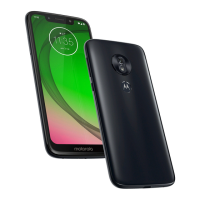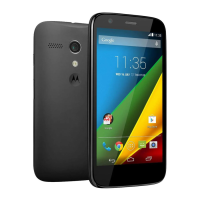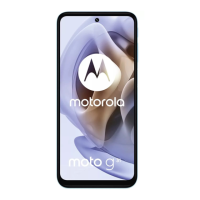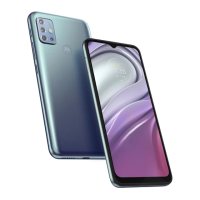Do you have a question about the Motorola moto g7 PLUS and is the answer not in the manual?
Diagram and description of the phone's physical components and ports.
Instructions for inserting and removing SIM and SD cards.
Steps to transfer data from an iPhone or Android phone to the new device.
Information on setting up and managing dual SIM cards for calls and data.
Guide to configuring personal and corporate email accounts on the phone.
Instructions for setting up emergency information and contact details.
Personalization options for the phone, including wallpaper and settings.
Explanation of the phone's home screen layout and navigation elements.
Details on how the lock screen functions and what actions can be performed.
Guidance for users transitioning from iPhone to an Android smartphone.
Explanation of icons displayed in the status bar and their meanings.
Description of touch, drag, swipe, and zoom gestures for phone navigation.
Instructions on using the navigation bar and customizing gestures.
How to access and customize quick settings for frequent adjustments.
Methods for capturing screenshots and adjusting screenshot settings.
Guide to using voice commands for various phone functions.
Instructions on using voice commands and widgets for navigation.
Using Digital Wellbeing to monitor and manage phone usage habits.
Tips for using the onscreen keyboard, including special characters and glide typing.
How to select, copy, cut, and paste text from web pages and messages.
Setting up and using autofill for personal information in forms.
Instructions for setting and changing the phone's wallpaper.
How to customize the app shortcuts in the Favorites tray.
Adding and managing widgets, app shortcuts, and folders on the home screen.
Information on changing the phone's look and feel using launchers.
Setting up and managing screen savers for the phone.
Managing running applications, including opening, closing, and switching between them.
Instructions for using split-screen view to run multiple apps simultaneously.
Overview of apps that come preloaded on the phone.
Methods for searching the web using Google Assistant and the search widget.
How to find apps, settings, and information on your phone.
Instructions for reading, replying to, and sending text messages.
Organizing messages, pinning conversations, starring messages, and deleting/archiving.
Steps for reading, replying to, forwarding, and sending emails.
How to add a personalized signature to outgoing emails.
Creating, editing, and deleting calendar events and managing notifications.
Instructions for setting alarms by touch or voice command.
How to use the timer and stopwatch functions on the phone.
Overview of Moto app features for customizing phone appearance and behavior.
Enabling the gesture to shrink the screen for easier one-handed operation.
Setting up and using hands-free mode for calls and voice commands.
Methods for wirelessly sharing photos and videos.
Automatic and manual backup options for photos and videos.
Adding, editing, merging, deleting, sorting, and sharing contacts.
Answering, making, and managing calls, including conference calls and blocking.
Listening to and managing voicemail messages.
Tuning into FM stations, managing favorites, and using sleep timers for radio.
Getting music via purchase, transfer, or cloud, and managing playback.
Connecting to Wi-Fi, managing networks, using Airplane mode, and controlling data usage.
Connecting with Bluetooth, NFC, and casting media to TVs.
Managing app settings, default apps, permissions, and notification preferences.
Charging the phone, extending battery life, and managing battery usage.
Managing phone storage, SD cards, cloud storage, and downloaded files.
Adjusting screen brightness, themes, colors, and font size.
Features for visual assistance, hearing aids, dexterity, and screen readers.
Managing screen locks, fingerprint sensor, face unlock, and location services.
Adding, removing, and managing Google and other app accounts.
Recording IMEI, finding legal info, customizing keyboards, and managing backups.
Troubleshooting common hardware problems like slow performance, heating, or screen issues.
Resolving problems with making/receiving calls, SIM card recognition, and signal.
Troubleshooting charging problems, overheating, and rapid battery drain.
Resolving issues with Bluetooth pairing, Wi-Fi connectivity, and USB file transfers.
Troubleshooting problems with installed apps, camera, and messaging.
Updating software, resetting network settings, and performing factory resets.
| Rear camera type | Dual camera |
|---|---|
| Front camera type | Single camera |
| Rear camera flash | Yes |
| Rear camera pixel size | 1.22 µm |
| Rear camera resolution (numeric) | 16 MP |
| Front camera resolution (numeric) | 12 MP |
| Second rear camera resolution (numeric) | 5 MP |
| Panel type | LTPS |
| Screen shape | Flat |
| Pixel density | 403 ppi |
| Display diagonal | 6.24 \ |
| Touch technology | Multi-touch |
| Touchscreen type | Capacitive |
| Display resolution | 1080 x 2270 pixels |
| Native aspect ratio | 19:9 |
| Gorilla Glass version | Gorilla Glass 3 |
| Display number of colors | 16 million colors |
| Themes | Wallpapers |
| Wireless charging | No |
| 4G standard | LTE-TDD |
| 2G standards | GSM |
| 3G standards | UMTS |
| SIM card type | NanoSIM |
| Wi-Fi standards | 802.11b, 802.11g, Wi-Fi 4 (802.11n), Wi-Fi 5 (802.11ac) |
| 3G bands supported | 850, 900, 1700, 1900, 2100 MHz |
| 4G bands supported | 850, 900, 1700, 1800, 1900, 2100, 2300, 2500, 2600 MHz |
| SIM card capability | Dual SIM |
| 2G bands (primary SIM) | 850, 900, 1800, 1900 MHz |
| Mobile network generation | 4G |
| Processor cores | 8 |
| Processor family | Qualcomm |
| Processor frequency | 1.8 GHz |
| Talk time (3G) | - h |
| Battery capacity | 3000 mAh |
| Battery technology | - |
| RAM capacity | 4 GB |
| Compatible memory cards | MicroSD (TransFlash) |
| Maximum memory card size | 512 GB |
| Internal storage capacity | 64 GB |
| Platform | Android |
| App distribution platform | Google Play |
| Operating system installed | Android 9.0 |
| Subscription type | No subscription |
| USB version | 2.0 |
| USB connector type | USB Type-C |
| Headphone connectivity | 3.5 mm |
| Multimedia Messaging Service (MMS) | Multimedia Messaging Service (MMS) is a standard way to send messages that include multimedia content to and from a mobile phone over a cellular network |
| Color name | Velvet Red |
| Form factor | Bar |
| Product color | Red |
| Cables included | USB |
| Depth | 8.3 mm |
|---|---|
| Width | 75.3 mm |
| Height | 157 mm |
| Weight | 176 g |











